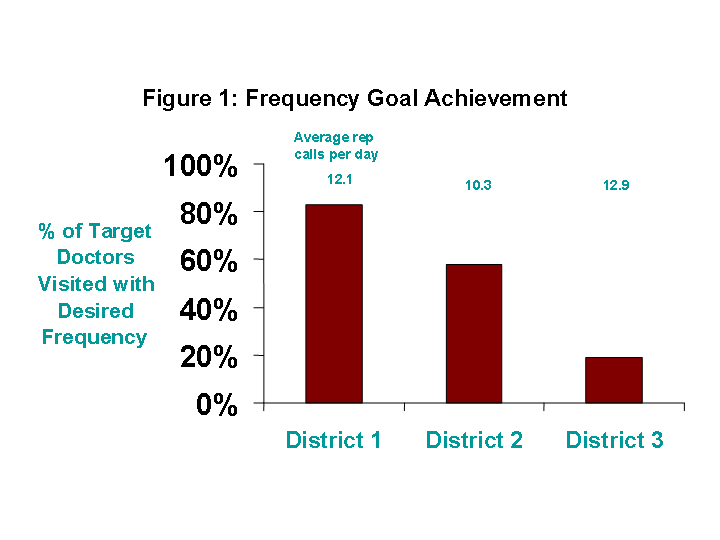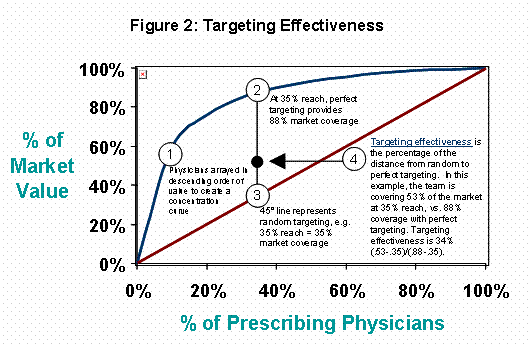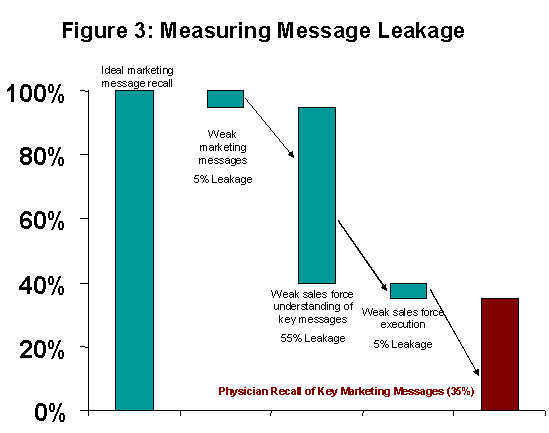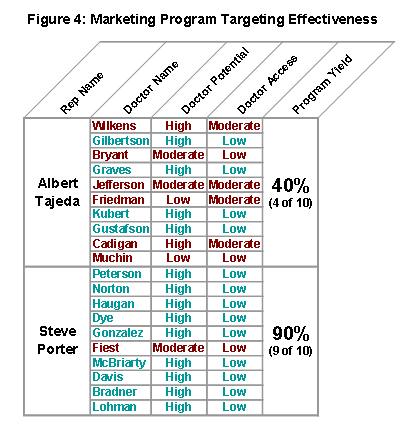 |
||||||
| May 2003 | ||||||
Measuring Sales Effectiveness and Monitoring Performance This month we conclude our four-part series on Sales Force Effectiveness (SFE) by focusing on measuring effectiveness and monitoring performance. Previous articles in the series described a process to:
The fourth component of the process involves measuring and monitoring improvement. Raising the level of sales force effectiveness requires sustained commitment and effort. By the time you’ve successfully completed the first three stages of the process, it’s tempting to declare victory and move on to other important priorities. Unfortunately, many otherwise successful sales force effectiveness initiatives ultimately fail because managers don’t fully implement an effective measurement and monitoring process. Why Measuring and Monitoring Are Important In previous articles we’ve identified the key drivers of sales success – targeting, frequency, message, and programs. Nevertheless, sales success also depends on intangible factors that are difficult to quantify, such as the rep’s ability to build relationships and “connect” with customers. For this reason, many managers argue that quantitative measures of sales effectiveness are either irrelevant or at best tell only part of the story. While we agree that the key drivers are not the only factors that determine sales results, our experience with hundreds of sales forces in more than 50 countries demonstrates that systematically and effectively measuring and monitoring key selling activities significantly improves sales results. Today most hospitals use standardized procedures to guide care teams involved in even the most complex disease treatment. Measuring and managing doctors’ compliance with protocols for lab tests, medications, and surgical procedures has helped dramatically improve average length of hospital stay, re-admission rates, mortality rates, and total costs. How can you apply similar approaches to improving your sales force productivity? In the pharmaceutical business, the ultimate measure of success is sales. Whether the metric is growth in total sales, new prescriptions, market share, or product switches, outcome measures are the best indication of success. But, just as patient mortality rates tell very little about the procedures that are most effective in healing people, sales figures alone don’t shed much insight on the behaviors and activities that drive sales success. To gain a broader understanding of sales performance, managers must effectively track and manage key behaviors and activities. The remainder of this article provides examples of key sales effectiveness metrics that will drive and sustain the impact of sales effectiveness initiatives. Key Sales Effectiveness Metrics Most pharmaceutical firms already track and manage sales activity. Unfortunately, the most commonly used measure – sales calls per day – is usually inappropriate and can often be counterproductive. By tracking calls per day, management often unintentionally encourages reps to visit easy-to-see, low-value doctors at the expense of the best target customers who are often harder to see with the desired frequency. A more effective metric is the percentage of target customers seen with the desired frequency (or frequency goal). Figure 1 highlights several insights from this simple metric:
· None of the sales districts in the example is achieving the desired frequency for all target customers · Calls per day performance is roughly equal for all districts, yet frequency attainment on key customers varies widely · District 3’s poor performance on frequency goal attainment and good performance on calls per day may indicate that · the number of target customers exceeds sales capacity, or · reps have substituted their own target list for management’s target list In this example, other factors being roughly equal, we would expect District 1 to significantly outperform the others because of its superior frequency attainment on key customers. Measuring the quality of the customer target list is an effective tool for improving market coverage and incremental sales. (Click on graphic to enlarge.) Figure 2 shows a simple targeting effectiveness metric that compares a sales force’s actual market value coverage to the best attainable market coverage given a particular reach of physicians. In this example, dropping lower-value doctors from the customer target list and adding higher potential doctors would significantly improve market coverage and incremental sales. See the article Targeting Higher Sales in this month’s newsletter for a more extensive discussion of the customer targeting process. Measuring message quality is critical to ensuring that reps are appropriately executing product positioning strategy. Firms commonly use third party market research to determine physician recall of key product messages. If recall is high yet sales lag, the marketing strategy may be flawed. However, if recall is low, management should implement a message leakage diagnostic and improvement strategy. Firms employ a number of research and testing tools to determine where message “leakage” is occurring. Figure 3 highlights key links in the chain of communication from message development to customer message retention. In this common example, reps simply don’t understand the key product messages. As a result, the product positioning strategy cannot be effectively executed. This firm should consider re-training reps on key messages and periodically testing them to ensure they have retained key information.
The simple metric shown in figure 4 assesses how well two reps implemented a speaker program designed for high-value, low-access physicians. It identifies an important opportunity for one rep, Albert Tajeda, to improve program execution. Conclusion In the operating room, a bypass surgeon’s behaviors can mean the difference between life and death. Similarly, the sales organization often determines whether a brand will flourish or flounder. In each case, by correlating key activities with results, managers determine those factors that drive success and manage behavior to improve outcomes. Pharmaceutical firms that effectively track and improve key sales activities will significantly outperform firms that focus solely on results. Questions If you have questions or would like to discuss the contents of this article, please send us an e-mail and a senior consultant will respond to you. Other Newsletter Articles This Quarter A Coach's Guide to Field Days -- Tiger Woods may be the greatest golfer of all time, but even Tiger attributes much of his success to having a great coach. Butch Harmon has coached Tiger for more than a decade and has helped him to consistently improve his performance. In many sales organizations, District Sales Managers (DSMs) spend two to four days a week in the field "coaching" their sales teams. This article describes how sales managers who implement a coaching process similar to Butch and Tiger's can significantly improve the performance of their reps. Targeting Higher Sales -- Anyone familiar with the game of darts knows how difficult it is to hit the bull's-eye -- even from a short distance. Now imagine trying to hit the bull's-eye while blindfolded. In the US, pharmaceutical sales reps and managers have extensive customer information on which to base customer targeting decisions. In many overseas markets, however, regulatory and market restrictions limit the information available to firms to assist the customer selection process. The article outlines a process for developing the information you need to effectively target customers when "perfect information" just isn't available. Prior Newsletters To view prior newsletters, please visit our newsletter index at http://www.rmcionline.com/html/news/ Subscribe/Unsubscribe Please click here to unsubscribe from the RMCI newsletter. Copyright Notice Copyright 2003, RM Consulting International. All rights reserved. Every viewer may copy, reprint or forward all or part of this newsletter to friends, colleagues or customers, so long as any use is not for resale or profit and the following copyright notice is included intact: "Copyright 2003, RMCI. All rights reserved."
|
||||||
 Let’s
consider another situation in which intangible skills play an important
role. During the 1980s hospitals began to track physician behaviors
on procedures such as bypass surgery or artificial hip replacement.
Seeing that physician behavior, and resulting patient outcomes,
varied greatly, hospitals established protocols to standardize behaviors.
Let’s
consider another situation in which intangible skills play an important
role. During the 1980s hospitals began to track physician behaviors
on procedures such as bypass surgery or artificial hip replacement.
Seeing that physician behavior, and resulting patient outcomes,
varied greatly, hospitals established protocols to standardize behaviors.



 Most firms measure the ROI for key marketing
programs. But they typically don’t track how well the sales force
executes them. As a result, firms may wrongly attribute a low ROI to poor
program design rather than poor sales execution. Most marketing programs
are designed to serve a specific customer segment. But many sales forces
take a scattershot approach to implementing those programs, offering them
to any doctor who will agree to participate.
Most firms measure the ROI for key marketing
programs. But they typically don’t track how well the sales force
executes them. As a result, firms may wrongly attribute a low ROI to poor
program design rather than poor sales execution. Most marketing programs
are designed to serve a specific customer segment. But many sales forces
take a scattershot approach to implementing those programs, offering them
to any doctor who will agree to participate.